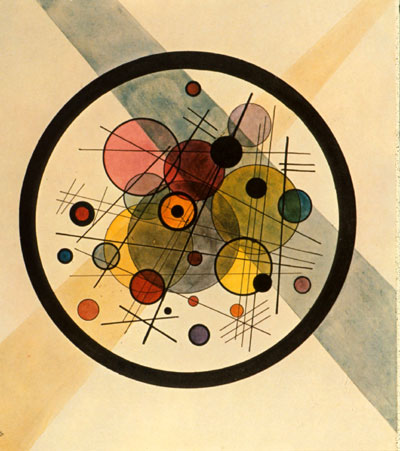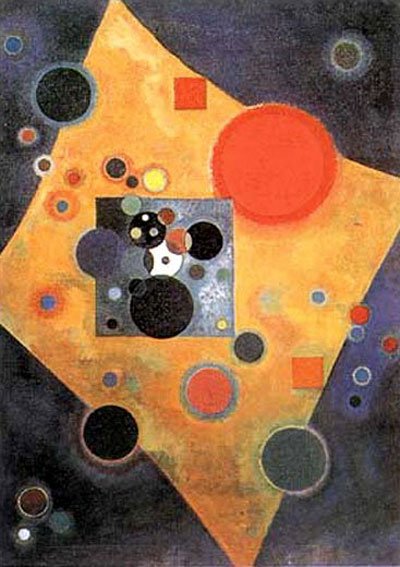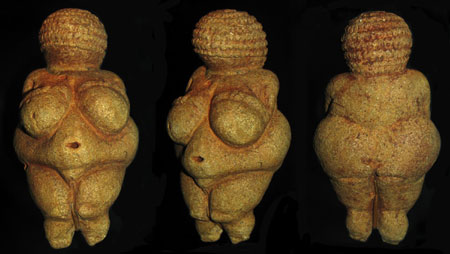|
There is often a good deal of serendipity involved in adventures of the mind. When a series of mental events leading to a possibly meaningful conclusion occurs, it is not unusual for this conclusion to be dependent upon something unintended and unforeseen, just as the "accident" that happens in a painting may point the artist in a new and more fruitful direction. It was Aristotle's notion that genius is the rapid perception of the relationships between things. Although it seems incomplete, I have always liked this definition of genius. The practice of art is certainly a process of finding the relationships between things, physical and abstract, and using these relationships in a significant and moving way. The challenge for the artist is to harmonize and compose the parts.
During a recent trip to New York City I spent a few hours in the Guggenheim, mostly looking at the exhibition of Kandinsky paintings from his Paris period. As I gazed rapturously at these paintings, some of which I had never seen, my thoughts turned to earlier Kandinsky paintings and to my friend, Lissa Renaud, a long-time contributor to Scene4 and an internationally recognized authority on Kandinsky, whose contributions are especially insightful in the area of Kandinsky's writings, his ideas on synesthesia, and his visions for a theater of the future. As I looked at the paintings, trying to regard them without prejudgment of any kind, they began to speak to me, they began trying to tell me something that I didn't understand and needed to understand. It was a fairly urgent message, it seemed to me, but one I simply could not decipher. Plato's saying that all knowledge is but remembrance came to mind. It was something I knew somewhere in my being, and I was trying to drag it up through the smoke and mirrors and chaos of the subconscious. It didn't help to stare at the paintings and try to analyze them. What they were telling me had little to do with analysis. The more I tried to figure out what the voice was saying, the fainter it became.
 |
Kandinsky, "Circles Within a Circle," 1923
 |
Kandinsky, "Accent on Rose" 1926
As we left New York the next day I was still scouring my mind for an answer. It was annoying, like forgetting a familiar word or name. Shortly after we arrived in California I met up with my niece Gabey, who was nine months pregnant, and I remarked to her that she reminded me a little of Kandinsky, with her semispherical belly. This observation did not produce an answer to the question that had been nagging me persistently, but, as it turned out, the sight of Gabey's belly was a stepping stone, a station along the way in my mental treasure hunt.
Two days later, as I was sitting in my studio thinking about Kandinsky again and trying in some way to resolve the matter that had been tormenting me for four days, my thoughts turned to another one of my favorite painters, Alexei Jawlensky, who, along with Kandinsky, Klee, and Feininger, was one of "The Blue Four." Then my thoughts went back eight years to my miraculous discovery of a large exhibition of Jawlensky paintings in a small museum at the edge of a little medieval town on the Danube, about eighty miles from Vienna. My companion and I had taken a river excursion boat from a place called Krebs to the town at the end of the line. Here my memory failed me, not in the Platonic view, but in the normal human sense. Determined to get the answer to this question, at least, I found my Vienna guidebook and turned to the page where there was a graphic of that stretch of the Danube we had covered. I scanned the irregular line of the river, stopping at some of the historic sites along its banks, the castle where Richard Lion Heart had been imprisoned, and so on. Just before coming to Melk, the town where we had serendipitously found the Jawlensky exhibit, the town whose name I had forgotten, my eye stopped at another ancient place along the river, the village of Willendorf, just above Melk. Here a wealth of Neolithic artifacts has been uncovered, including the famous Venus of Willendorf, a 24,000 year old limestone sculpture of a rotund pregnant woman. I reflected that the Neolithic artists painted and sculpted according to what they understood was important. And one of the things that was very important to them was fertility. In the guide book there was a tiny drawing of the Venus, and as soon as I focused on it the proverbial light above my head turned on. All the pieces of the puzzle fell into place, as they say. What Kandinsky's paintings had been trying to tell me was that they were about fertility. Cosmic fertility no less.
 |
"Venus of Willendorf" three angles
It wasn't just the circles, which of course may represent many things, nor was it that the sphere is the most potent and fundamental of all symbols, it was the way Kandinsky's circles and triangles and swirls and trapezoids and trapeziums all intermingle in a three dimensional way, creating an impression of cosmic intercourse. Geometric or not, Kandinsky's highly symphonic compositions are bursting with energy and life.
Kandinsky, "Around the Circle" 1940
The urgency of the message, I believe, had to do with the fact that I am a painter, and of late my work has been going in a Kandinskyish direction, for reasons unknown. This little adventure of the mind, resulting in the eventual apprehension of "cosmic fertility," has given me a welcome concept to work with, the kind of concept that involves the simple, the obvious, the mysterious, and the complex.
David Wiley, "Certain Rites of Summer"
David Wiley, "Kandinsky's Boat"
As a coda to this business perhaps Lissa Renaud could be persuaded to create a theatrical production based on the story. It could have Neolithic people making art and other things, cosmic scenes and events, triangles of every possible kind, and all known shades of color, each one making a sound of its own and emitting a fragrance different from all others.
Kandinsky, stage set for "The Gnomes" Mussorgsky's Pictures at an Exhibition, 1928
View an animated work made with Kandinsky's "Composition VIII" and extracts from Stravinsky's "The Rite of Spring" by myorkvzla.
Cover Image - David Wiley, "Valeria"
|